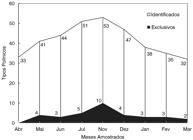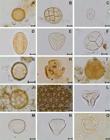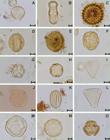Propolis is a resinous substance collected by bees from different parts of a plant. Therefore, its quality is related to its botanical origin. The objective of the study was to verify whether the pollen types found indicate the botanical origin of their resins and contribute to understand the relationship of these bees with the vegetation surrounding the meliponary. Thirty one samples were collected over 12 months at seven day intervals. Pollen grains were extracted from the propolis and used to prepare microscope slides, after which identification, counting and determination of frequency classes was undertaken. A total of 94 pollen types were identified belonging to 35 plant families. Borreria verticillata (34.17%) was the most frequent pollen type, followed by Anadenanthera sp. (13.65%) and Mimosa caesalpiniifolia (10.5%). Fabaceae (38.37%) and Rubiaceae (34.18%) were the families with the highest pollen frequencies. There were also found 34 unique pollen types, i.e. types that only occur on a given month of the year which may be characterised as seasonal indicators for flowering species and thus infer data on their phenology. The results obtained were not enough to determine the botanical origin of the resins; however the wide variety of pollen types found in the propolis samples indicated a broad interaction between bees and plants and contributed toward the phytogeographic characterisation of the propolis.
stingless bees; beekeeping; pollen

 Pollen spectrum of Scaptotrigona aff. postica
(Hymenoptera, Apidae, Meliponini) propolis from Barra do Corda, MA,
Brazil
Pollen spectrum of Scaptotrigona aff. postica
(Hymenoptera, Apidae, Meliponini) propolis from Barra do Corda, MA,
Brazil Thumbnail
Thumbnail
 Thumbnail
Thumbnail
 Thumbnail
Thumbnail
 Thumbnail
Thumbnail




